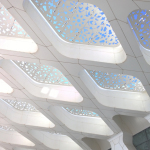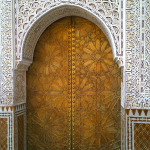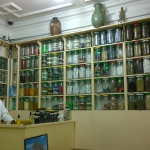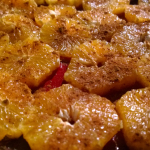Arriving at the airport in Faro was… Quick. The taxi driver was going at 130-140km/hr and we got there in about 10 minutes.
Apparently either we were too late or too early, our luggages were marked for free check-in as the cabin would be full. Either way, this gate didn’t seem to care much about weight or size. We can only hope for the same in Paris (BVA)… Flight time, 2 hours.
Landed at the airport with plenty of time to spare to catch our connecting flight. Beauvais is extremely small. It looked like 1 or 2 arrivals baggage belt and 5 departure gates. Still pretty busy though. But we had just enough time to grab a pastry at the airport and shop around in the duty free while we waited for Karen’s friend, Sameer, and the plane to start boarding. Again, Ryanair didn’t seem to care much about the size or weight restrictions this flight… Better safe than sorry though.
Sameer arrived just as people started to line up to board the plane (11:50am), despite being in Paris since 7am landing in Charles de Gaulle. Poor guy… He took the scenic route to from CDG to BVA, making a quick pitstop at the Eiffel Tower, he just didn’t account for the unaccountable Paris traffic jams, and the busses that don’t show up. The only way he made it on time was to cab. You know those cabs who hang out by the bus stops to the airport? Just waiting for the desperate ones? Yea. Those cabs. Hefty bill, but better than missing the flight to Morocco. Flight time, 3:25 hours to Marrakech.
Landing in Marrakech, we are greeted by an hour long line-up to get through Passport Control. Whee. Why? Who knows. When we got to the windows it took all of 30 seconds to stamp each of us through. Baggage Claim was just beyond and someone could have easily swiped them up, it’s a good thing we did carry-on. The airport was built fairly recently, about 4 years ago, so the design of the public-facing walls and ceilings were pretty cool. Met up with our tour guide through Marrakech, Sa’id, and we were on our way into the Medina of Marrakech.
He was telling us so much about the history of Morocco, it was too much to take in. Let’s see what I remember… I apologize in advance if I’m wrong or offensive. The outer walls of the medina were built for fortification of the city and the holes in the walls were to ventilate the actual walls and the city within it. The walls were taller before but erosion has shortened them. The 4 imperial cites were Fez, Marrakech, Meknes, and currently, Rabat. Each city built to overrun the previous imperial family, built by Arabs, Berbers,… Can’t remember. Errr.. Dormedary are camels with one hump…… A road is a traditional Moroccan house or palace with an interior garden or courtyard. None of the windows face outside, only into this courtyard for security purposes. As we arrived at the drop off spot for our Riad, a random guy with a cart showed up and started to load our luggage. Sa’id said he is trustworthy and would bring our bags to our Riad, so we just.. let that happen. Lots of bikes and motorbikes driving through the alleyways. It felt literally like a maze of clay walls, some with ceilings and floors.
After making a stop to pick up Dirhams from the ATM, we were led through the small alleys towards our Riad, Riad Princese du Désert. Twists, turns, at the end of an alley, there we find it. Met at the door by our host who served us the traditional Moroccan mint tea with biscuits. I’ve definitely had it before though, in Toronto. Sultans tent in downtown. After a little freshening up, we head out again.
Sa’id walked us out into a random Riad, that almost looked abandoned but wasn’t… Anyways, he told us about the way the cities are built, with a mosque in the middle, the four pillars, then supporting those pillars, the outer wall, and the rest is left for houses. The four pillars are what the city needs to develop a community. A fountain, a hammam (public bath), a baker, and a school for children. Clever individuals worked inside the walls as artisans while the less clever outside the walls as farmers. Extending from the center of the city, workshops were built for the artisans. He continued with some history of the Berber, their language, and dialects. The main three are the Riff with the Riffi dialect, Souss and Soussi dialect, and the largest, Amazight people with the tamazight dialect. Each of these names coming from the region in which they reside. While Amazight people are all over. Their writing is heavily influenced by Arabic script and if they are not speaking in their native tongue, French seems to be the immediate second if not first. Most Moroccan people are referred to as Berber, however, Berber is a derogatory term, short for barbarian. They are slowly changing their name into Amazight (I think) which means “free people”, tamazight meaning, the dialect is the free people. There was a time when Judaism entered into Morocco but was eventually converted into Muslim… He just kept on going, I don’t know if I missed anything.
We then continued our walk, as the building we were in was closing? Apparently it was some kind of business… Sa’id took us to the Baker, who basically did all the baking for the families. The families brought their dough and he would make the bread for them. He didn’t use wood, but paper and the waste from carpenters to cook.
He then showed us the Hammam, which consists of several rooms for different stages of the bath. Sweating, scrubbing, washing.. With scented soaps and such.
Continuing through the maze, he led us through the leather workshops that were closed, inhabited by many stray cats. This then led to more and more open stores selling locally made bags, belts, shoes, leather goods. Keep going, it got more and more crowded. Out of the workshop area and into the marketplace, closer to the middle of the city. It then opened up to the main square where stalls were setup selling many different things. Grapefruit orange juice, music, food.. There were snake charmers, monkey handlers, it was quite the scene.
Away from the main square, we visited the herbologist, who sold many spices for health and cooking. Through a brief lesson, he showed us some of the popular spices and herbs used for common things such as headaches. Back through the maze to get to our Riad. Sa’id showed us a path that led almost straight to our Riad. Only one or two turns.
Arriving at our Riad, we chilled a little and dinner was then served on the rooftop terrace. A Moroccan soup, an eggplant dish, and bread. It was still kind of early so we made plans to go back into the market before it closed at 930.
Starting to get ready, our host comes to our rooms and starts calling out. Hello? Hello?… Apparently, he must have gone upstairs and saw that we were gone. We weren’t sure, but that was just the first course. Time for our main. Hahaha, that was a little embarrassing… Our main course was brought up shortly afterwards, a chicken dish, very good. With some laughs, we were told that there was to be a dessert course afterwards as well. Oranges with cinnamon and sugar, refreshing.
We had a discussion about tipping. We don’t know who, when, and how much to tip. Because we’re doing a tour, there are always random people, carrying our luggage, serving food, driving… What’s the common, acceptable practice in Morocco? Anyways, by this time it was too late to venture out into the market, the food had made us tired anyways.
Back in our rooms, suddenly, music was coming from the inner courtyard. Dancing, alcohol, and good times. Our host had some friends over and a couple of tourists as well. We are given traditional garbs and danced along until we were too tired to do anymore.
Goodnight Marrakech.
Marrakech Airport, Random Doorway, Herbologist, Oranges with Cinnamon and Sugar




Post a Comment